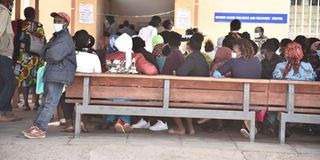How thousands of patients lost access to healthcare overnight

Patients at Nakuru Provincial General Hospital in this picture taken on February 2, 2021.The facility serves the larger South Rift region.
The doors remain open, but the digital gates have slammed shut.
Across five Kenyan counties, thousands of patients seeking dialysis, maternity care, and other essential services have found themselves stranded—not because their local health facilities have physically closed, but because they've been quietly locked out of the Social Health Authority (SHA) system without warning.
The director of Giftland Medical Centre in Nyamira County, one of the affected facilities, arrives each morning to find patients queuing outside, unaware that the facility can no longer process their SHA claims.
Two weeks ago, everything was functioning normally.
The Kenya Medical Practitioners and Dentists Council (KMPDC) had conducted their routine inspection, and there had been no indication of problems. Three days later, the SHA portal went dark.
"My facility, was inspected by KMPDC two weeks ago in Nyamira County. Three days later, the SHA portal was suspended," the director explains, frustration evident in their voice.
"When I sought to know why, I was told it's because of late licence renewal, so I fail to understand how that affects the facility yet the inspection exercise was successful as I was not informed that there was a problem."
Giftland Medical Centre’s story is not unique.
Across Nyamira, Kisii, Mandera, Wajir, and Nairobi counties, 1,029 health facilities have found themselves in digital limbo—either completely shut out of the SHA system or downgraded in ways that fundamentally alter the services they can provide.
"We have been in a limbo for the last two weeks. I am not getting any assistance either from KMPDC or SHA," the director adds, speaking for hundreds of facility owners who have been left without answers or recourse.
What patients and healthcare providers are experiencing is the result of what investigations reveal to be an unprecedented administrative action.
The Health ministry, without following the legally required due process for downgrading or shutting down health facilities, tasked the KMPDC, Digital Health Agency (DHA), and SHA to simply lock facilities—predominantly Level 3 hospitals—out of the system, even after collecting registration fees.
The implications are far-reaching and immediate. Level 3 hospitals, defined by their ability to offer inpatient services, specialised clinics such as dental and X-ray facilities, and comprehensive maternity care including antenatal and postnatal services, suddenly find themselves unable to provide these crucial services through the SHA system.
Level 3 facilities
In Kenya's healthcare hierarchy, Level 3 facilities represent a critical middle tier. Typically run by doctors, they serve as a step up from dispensaries and clinics (Level 2) by providing a broader range of services.
For patients requiring dialysis, cancer treatment, or emergency obstetric care, these facilities often serve as their primary access point to healthcare.

Out patients wait for attendance at the Nakuru Level Five Hospital on June 12, 2017.
The financial architecture of SHA makes these downgrades particularly devastating. The funds that SHA operates are intrinsically linked to hospital levels, meaning access to the Social Health Insurance Fund (SHIF) requires facilities to maintain at least Level 3 status. Dialysis and cancer centres fall under this umbrella.
When a facility is downgraded to Level 2, the services that were previously approved are immediately rejected by the portal. For SHA, this represents significant cost savings—millions that would otherwise have been spent processing claims from these facilities.
The scope of the exercise becomes clear when examining the numbers county by county.
In Kisii, established facilities such as Millennium Medical Centre Etago, Kenyenya Medical and Diagnostic Centre, Marble Healthcare, and Ogembo Medical Centre have had their SHA portals suspended. Nyamira has seen facilities like Nyamusi Medical Centre affected amongst others.
The statistics paint a picture of systematic restructuring. Health Cabinet Secretary Aden Duale provided a comprehensive breakdown of the inspection exercise:
"In Mandera, 269 health facilities were inspected with 58 being closed down and 60 downgraded. In Nairobi, 1,017 were inspected with 394 being closed down and 23 downgraded. In Wajir, 239 were inspected with 77 being closed down and 114 downgraded. In Kisii, 291 were inspected with 120 being closed down and 63 being downgraded, whilst in Nyamira, 167 were inspected, 79 closed down and 41 downgraded."
According to Duale, the goal is clear: "Their goal is to eliminate fake unlicensed facilities operating across the country so as to guarantee quality of care for all Kenyans."
The Health CS maintains that the affected facilities are non-compliant. "Through digitalisation, the Kenya Medical Practitioners and Dentists Council (KMPDC), working closely with the Digital Health Agency (DHA) and SHA, has identified and closed 728 non-compliant facilities and downgraded 301 facilities," he stated.
However, the medical community tells a different story. The Rural & Urban Private Hospitals Association of Kenya (Rupha) has found itself fielding calls from confused and frustrated members across the affected counties.
"It is very possible that there are many affected hospitals who do not know yet that they are downgraded. Our members in Kisii, Migori, and Nyamira have been reaching out as many are directly affected," Rupha representatives explained during a Monday interview.
The association raises fundamental questions about the legal process. "Quite a number of Level 3 facilities have been downgraded to Level 2.Closing down a health facility has to be by official notice, and the Health Ministry has not sent any notices that we know of."

The Rural Private Hospitals Association of Kenya chairman Brian Lishenga.
Dr Brian Lishenga, chairperson Rupha, speaking on behalf of affected facilities, highlighted the procedural concerns: "What they have done is lock people out of the SHA portal because they have no power to physically close. Revocation of a licence is a legal process and is not something you just wake up one day and say I have revoked."
His assessment suggests the impact is nearly universal in some regions: "Almost all Level 2 and Level 3 health facilities in Nyamira and Kisii are affected."
An exercise in expansion
According to Dr Lishenga, what began in Kisii and Nyamira counties represents the opening phase of a national exercise.
"The exercise by the Health ministry is ongoing as they move to other counties. This is strange because the facility inspections had already been done before."
The inspection process itself has come under scrutiny. Traditional healthcare facility inspections typically involve self-assessment components, allowing facilities to evaluate their own compliance status alongside official evaluators. However, this exercise appeared to follow a different protocol.
"Facilities are required to fill self-assessments, which they did not. The inspection was totally one-sided; they were not given notice and it was sort of like they were being ambushed," he disclosed.
The aftermath has proven equally problematic. Standard inspection procedures require feedback sessions where facilities learn of deficiencies and receive opportunities to implement corrective measures.
"Once you assess a provider, you are supposed to give them feedback, and usually you give them a chance to take corrective steps. No one gave them that chance or officially communicated the outcome of the inspection. The only thing they are seeing is that they have been downgraded in the SHA portal."
Despite the controversy surrounding facility closures and downgrades, CS Duale presented statistics suggesting SHA's overall success. The authority has contracted 9,365 healthcare facilities nationwide, including 5,219 public, 3,650 private, and 496 faith-based (FBO) facilities, enabling service access for 5.7 million Kenyans.

Health Cabinet Secretary Aden Duale addresses the media at the Ministry of Health headquarters in Nairobi, on April 10, 2025.
As of June 16, 2025 at 12:30pm, 23,674,672 Kenyans have enrolled in TaifaCare, with 28,679 new registrations recorded. Additionally, 5,483,160 Kenyans have undergone means testing to determine their premium contributions.
Through the Primary Healthcare Fund (PHCF), 3.6 million Kenyans have received free treatment for common illnesses, including malaria, pneumonia, injuries, and mental and eye health services. Expectant mothers have also accessed antenatal and postnatal care through the system.
"SHA has processed Sh5.4 billion in PHC claims, with 53 per cent going to public facilities, 38 per cent to private facilities, and 9 per cent to FBO facilities, and Sh1.2 billion for the month of May 2025 will be paid tomorrow," CS Duale announced on Monday.
For SHIF, from October 2024 to June 2025, a total of Sh43.8 billion has been paid out, including Sh6.2 billion that was disbursed on 13th June 2025.
The ministry has also announced strategic partnerships aimed at expanding access whilst reducing costs.
"In a bid to streamline services, expand access, streamline services and reduce the cost of care, the Ministry of Health is collaborating with the private sector, having started with the Aga Khan University Hospital and The Nairobi Hospital for specialised health services—oncology and renal services that include kidney transplant at the gazetted SHA tariff rates with no out-of-pocket payments."


